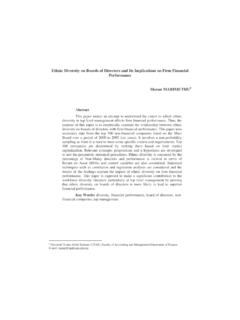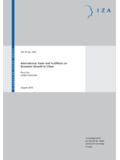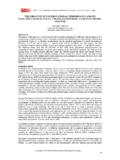Transcription of The Production Function for Housing: Evidence from France
1 The Production Function for housing : Evidence from FrancePierre-Philippe Combes Aix-Marseille School of Economics and Sciences PoGilles Duranton University of PennsylvaniaLaurent Gobillon Paris School of EconomicsWork in progress: December 2015 Abstract: We propose a new non- parametric approach to estimatethe Production Function for housing . Our estimation treats output as alatent variable and relies on the first-order condition for house parcels of similar sizes, we compute housing by summing across themarginal products of non-land inputs. In turn, differences in non-landinputs are caused by differences in land prices that reflect differences inthe demand for housing across locations. We implement our methodol-ogy on recently-built single-family homes in France .
2 We find that theproduction Function for housing is reasonably well approximated by aCobb-Douglas Function and close to constant returns. After correctingfor differences in user costs between different inputs, we obtain a shareof land of about 20% in the Production of words: housing , Production :r14, r31, r32 We thank seminar and conference participants and in particular Nate Baum-Snow, Felipe Carozzi, Tom Davidoff,Uli Doraszelski, Jean-Franois Houde, and Tony Yezer for their comments and suggestions. We are also grateful to theService de l Observation et des Statistiques (SOeS) - Minist`ere de l Ecologie, du D eveloppement durable et de l Energiefor giving us on-site access to the data.
3 Aix-Marseille University (Aix-Marseille School of Economics),cnrs,ehessandgreqam, 2 Rue de la Charit e,13002 Marseille, France and Sciences Po, Economics Department, 28, Rue des Saints-Pres, 75007 Paris, website: ). Also affiliated with the Centre forEconomic Policy Research. Wharton School, University of Pennsylvania, 3620 Locust Walk, website: ). Also affili-ated with the Center for Economic Policy Research, the Spatial Economic Centre at the London School of Economics,and the Rimini Centre for Economic Analysis. pse-cnrs, 48 Boulevard Jourdan, 75014 Paris, France website: ). Also affiliated with the Centre for Economic Policy Research and the Institute for theStudy of Labor (iza).
4 1. IntroductionWe propose a new non- parametric approach to estimate the Production Function for housing . Ourestimation treats output as a latent variable and relies on the first-order condition for house parcels of similar sizes, we compute housing by summing across the marginal products ofnon-land inputs. In turn, differences in non-land inputs are caused by differences in land pricesthat reflect differences in the demand for housing across locations. We implement our methodologyon recently-built single-family homes in France . We find that the Production Function for housingis reasonably well approximated by a Cobb-Douglas Function and close to constant returns. Aftercorrecting for differences in user costs between different inputs, we obtain a share of land of about20% in the Production of good understanding of the supply of housing is important for a number of reasons.
5 First, housing is an unusually important good. It arguably provides an essential service to households andrepresents around 25% of their expenditure in both theusand France (Davis and Ortalo-Magn e,2011, Commissariat G en eral au D eveloppement Durable, 2011). It is also an unusually importantasset. The value of theusresidential stock owned by households was around 20 trillion dollar in2007 (Gyourko, 2009). French households owned about trillion dollar worth of housing in 2011(Mauro, 2013). For both countries, this represents about 180% of their gross domestic and the construction industry also matter to the broader economy. The constructionindustry, which in France employed about 8% of the workforce in 2011, is arguably an importantdriver of the business cycle ( , Davis and Heathcote, 2005).
6 The role of housing in the greatrecession has been studied by, among others, Chatterjee and Eyigungor (2011) and Kiyotaki,Michaelides, and Nikolov (2011). The broader effects of housing are not limited to the businesscycle. housing has also been argued to affect a variety of aggregate variables such as unemployment(Head and Lloyd-Ellis, 2012, Rupert and Wasmer, 2012) or economic growth (Davis, Fisher, andWhited, 2011).Finally, and most importantly, housing is also central to our understanding of cities. Differentlocations within a city offer different levels of accessibility and bundles of amenities. Housingproduction is central in transforming the demand for locations from households into patterns ofland use and housing consumption.
7 Unsurprisingly, housing is at the heart of land use models inthe spirit of Alonso (1964), Muth (1969), and Mills (1967) that form the core of modern urbaneconomics. The exact shape of the housing Production Function has important implications for thewelfare properties of a range of planning regulations (Larson and Yezer, 2013). In particular, the1welfare consequences of extent land use restrictions such as minimum lot size limits will depend onhow substitutable land is in the Production of Muth s (1969, 1975) pioneering work, there is a long tradition of work estimating aproduction Function for housing . The early literature is reviewed in McDonald (1981). A standardapproach is to regress some measure of property prices on the values of land and other inputs in acost-share estimation of a Cobb-Douglas Production closely related alternative is, likeAlbouy and Ehrlich (2012), to estimate a cost Function using land price data and a constructioncosts generally, the estimation of the Production Function for housing is traditionally conductedin the same way we estimate Production functions or cost functions for other goods in productivitystudies (see Ackerberg, Benkard, Berry, and Pakes, 2007, Syverson, 2011, for recent reviews of theliterature estimating Production functions ).
8 2 Results are generally supportive of constant returnsto scale in the Production of housing and estimates for the elasticity of substitution between landand other inputs typically range between and approaches to the estimation of the Production Function for housing suffer from anumber of problems. First, housing is highly heterogeneous. Any given residential property isessentially unique due to the uniqueness of locations. Properties also differ by their size, quality,and a range of other characteristics such as their partition into room, their architectural style, ortheir level of maintenance. As a result, when a property is transacted, we can observe the value ofthe transactionP Hbut not the true quantity of housing being tradedHnor the price per unitP.
9 This is a version of the unobserved price / unobserved quality problem that usually plagues the1To estimate a more general constant-elasticity-of-substitution Production Function , past research has often re-gressed the capital to land ratio of properties on the price of of their land. This directly estimates the elasticityof substitution between capital and land in the Production of housing . However, as it involves regressing ratios ofquantities on prices instead of prices on quantities, this type of estimation is, if anything, more problematic than theestimation of the Production , Gordon, and Sieg (2010) is an exception. We discuss their approach in greater details below after sketchingour own of Production functions .
10 This problem is particularly acute with a largeurban area, the price of a square meter of housing easily varies by a full order of to separate prices from quantities also matters more with housing . In many productionfunction contexts, knowing how much revenue firms can generate from inputs is often something wecare deeply about whereas, for housing , actually knowing how many units of housing are suppliedis of utmost , we also acknowledge some parcels may be more suitable for housing Production in a waythat is not observable to the analyst. To draw a parallel with the standard estimation of productionfunction, some parcels may be more productive than others. As a result, more housing will be builton more productive parcels and, in turn, this will affect input choices.






